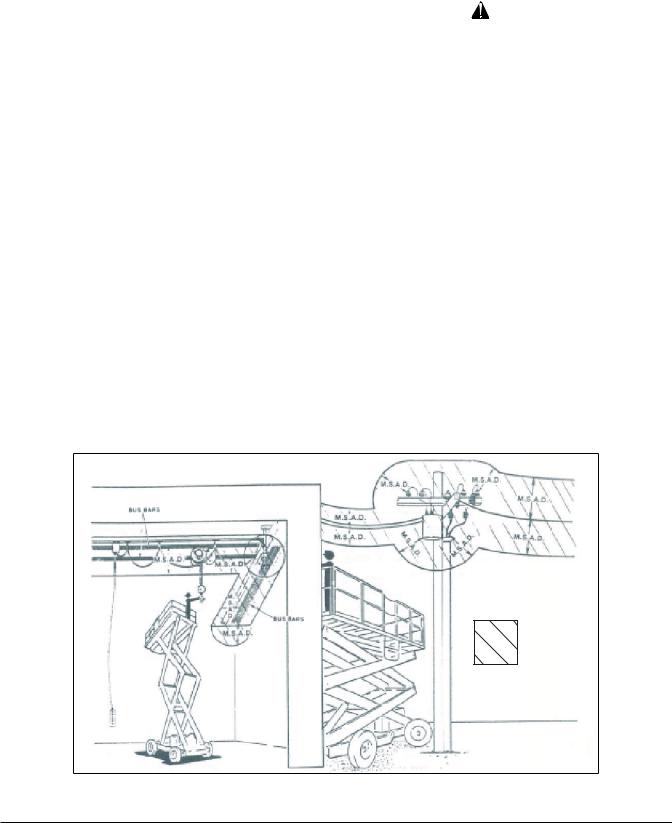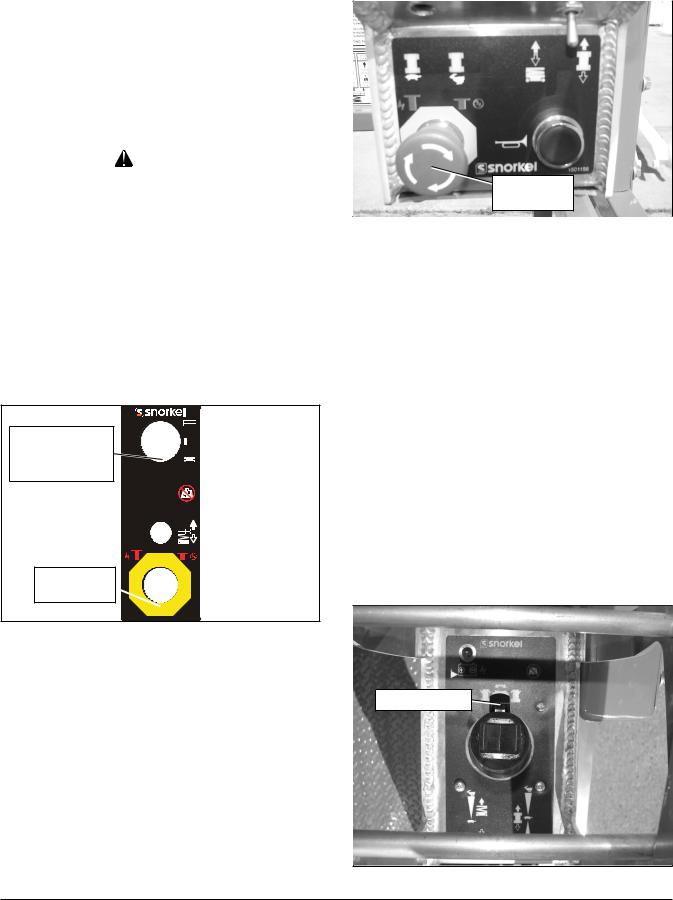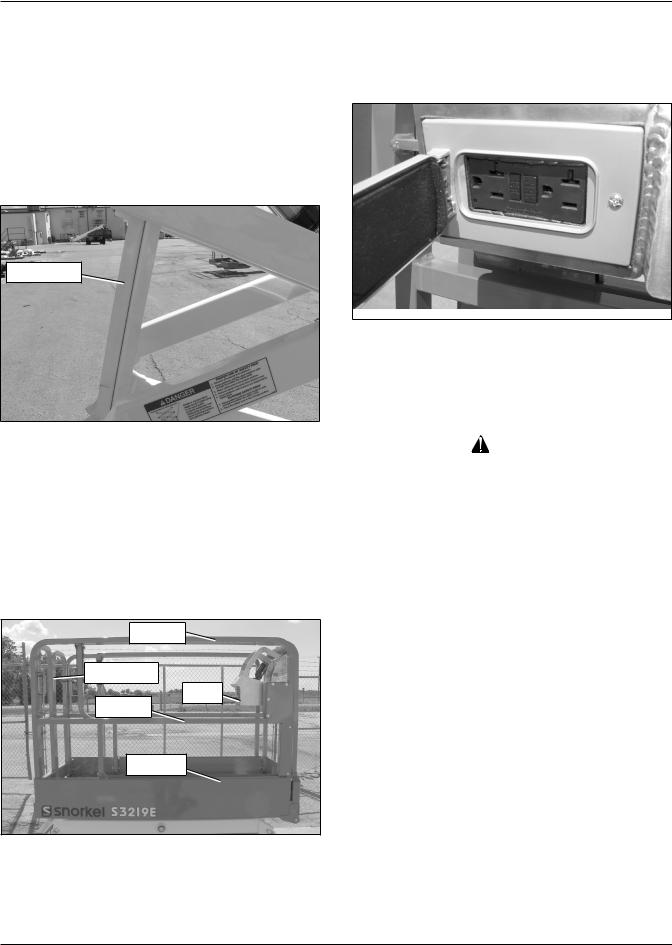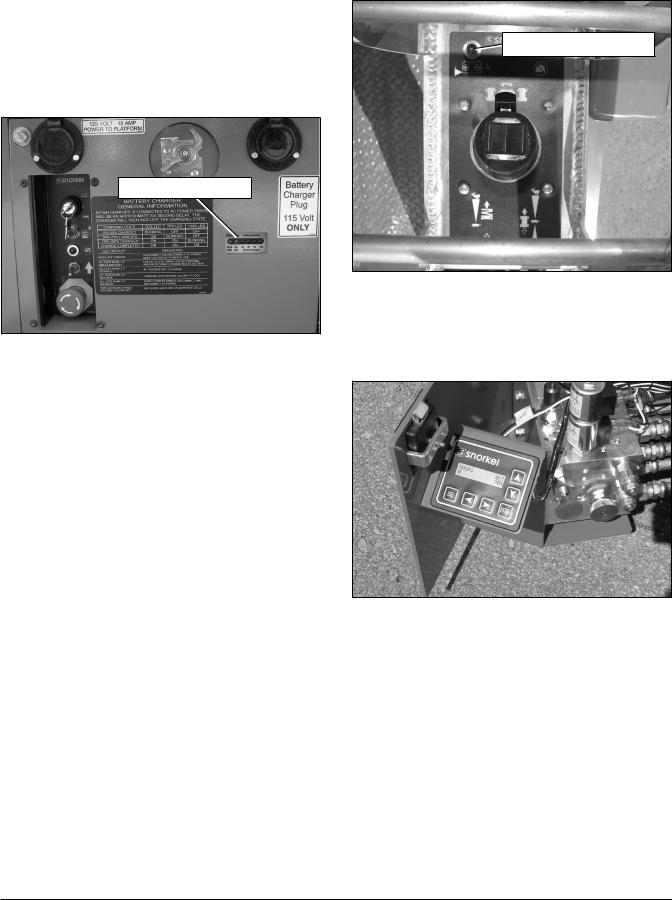Snorkel S3219E User Manual

OPERATOR’S
MANUAL
Part Number 1500834
July 2014
Serial number 000000 and after

The aerial platform is not electrically insulated. Death or serious injury will result from contact with, or inadequate clearance from, an energized conductor.
Do not go closer than the minimum safe approach distance as defined by the Minimum Safe Approach Distance section in Chapter 3–Safety.
Regard all conductors as energized.
Allow for electrical wire sag and aerial platform sway.
If the platform, scissors structure, or any part of the aerial platform contacts a high-voltage electrical conductor, the entire machine can become electrically charged.
If that happens, remain on the machine and do not contact any other structure or object. This includes the ground, adjacent buildings, poles, and any other objects that are not part of the aerial platform.
Such contact could make your body a conductor to the other object, creating an electrical shock hazard resulting in death or serious injury.
If an aerial platform is in contact with an energized conductor the platform operator must warn ground personnel in the vicinity to stay away. Their bodies can conduct electricity creating an electrical shock hazard resulting in death or serious injury.
Do not approach or leave the aerial platform until the electricity has been turned off.
Do not attempt to operate the lower controls when the platform, scissors structure, or any part of the aerial platform is in contact with a high-voltage electrical conductor or if there is an immediate danger of such contact.
Personnel on or near an aerial platform must be continuously aware of electrical hazards, recognizing that death or serious injury can result from contact with an energized conductor.
California
Proposition 65 Warning
Battery posts, terminals, and related accessories contain lead and lead components, chemicals known to the State of California to cause cancer and birth defects or other reproductive harm. Wash hands after handling.

Table of Contents
Electrical Danger............................... |
inside front cover |
|
Proposition 65 Warning..................... |
inside front cover |
|
Chapter 1 – Introduction |
|
|
Aerial Platform Features............................................. |
|
1 |
Options........................................................................ |
|
1 |
Operator’s Manual...................................................... |
|
1 |
Safety Alerts................................................................ |
|
1 |
Operation.................................................................... |
|
1 |
Maintenance................................................................ |
|
2 |
Manual of Responsibilities.......................................... |
|
2 |
Additional Information................................................. |
|
2 |
Chapter 2 – Specifications |
|
|
Component Identification............................................ |
|
3 |
General Specifications – S3219E............................... |
|
4 |
Aerial Platform......................................................... |
|
4 |
Platform.................................................................... |
|
4 |
Function Speed........................................................ |
|
4 |
Drive System............................................................ |
|
4 |
Drive/Lift Level Sensor Interlock.............................. |
|
4 |
Tires......................................................................... |
|
4 |
Electrical System..................................................... |
|
4 |
Hydraulic System..................................................... |
|
4 |
Ambient Air Temperature Operating Range |
.............4 |
|
Maximum Wind Speed............................................. |
|
4 |
Chapter 3 – Safety |
|
|
Electrocution Hazards................................................. |
|
5 |
Minimum Safe Approach Distance.............................. |
|
5 |
Prestart Inspection...................................................... |
|
6 |
Work Place Inspection and Practices.......................... |
|
6 |
Operation.................................................................... |
|
6 |
Tip-Over and Falling Hazards..................................... |
|
6 |
Electrical System......................................................... |
|
7 |
Hydraulic System........................................................ |
|
7 |
Placards and Decals................................................... |
|
7 |
Chapter 4 – Safety Devices |
|
|
Emergency Stop Controls........................................... |
|
9 |
Control Select/Ground Operation Switch.................... |
9 |
|
Upper Control Interlock Switch.................................... |
|
9 |
Drive Motion Alarm.................................................... |
|
10 |
Pothole Protector Skids............................................. |
|
10 |
Drive/Lift Pothole Protector Interlock......................... |
|
10 |
Drive/Lift Level Sensor Interlock............................... |
|
10 |
Lowering Alarm......................................................... |
|
10 |
Emergency Lowering Lever...................................... |
|
10 |
Safety Prop............................................................... |
|
11 |
Guardrails.................................................................. |
|
11 |
Ground Fault Circuit Interrupter................................ |
|
11 |
Tilt Alarm................................................................... |
|
11 |
Horn.......................................................................... |
|
11 |
Flashing Light............................................................ |
|
11 |
Chapter 5 – Gauges and Displays |
|
Battery Charge Indicator .......................................... |
13 |
Battery Condition Indicator........................................ |
13 |
Diagnostic Center Display......................................... |
13 |
Chapter 6 – Batteries |
|
General Maintenance................................................ |
15 |
Charging.................................................................... |
15 |
Chapter 7 – Controls |
|
Battery Disconnect.................................................... |
17 |
Lower Controls.......................................................... |
17 |
Emergency Stop Button......................................... |
17 |
Control Selector/Ground Operation Switch............ |
17 |
Platform Raise/Lower Switch................................. |
17 |
Upper Controls.......................................................... |
18 |
Emergency Stop Button......................................... |
18 |
Drive/Lift Selector Switch....................................... |
18 |
Joystick.................................................................. |
18 |
Interlock Switch...................................................... |
19 |
Steer Switch........................................................... |
19 |
Drive Range Switch – S4732E............................... |
19 |
Horn Button............................................................ |
19 |
Battery Condition Indicator..................................... |
19 |
Circuit Breaker Reset Button..................................... |
19 |
Chapter 8 – Prestart Inspection |
|
Operator’s Manual.................................................... |
21 |
Electrical System....................................................... |
21 |
Battery Fluid Level................................................. |
21 |
Battery Terminals................................................... |
22 |
Battery Charger...................................................... |
22 |
Safety Prop............................................................... |
22 |
Cables and Wiring Harness...................................... |
23 |
Hydraulic System...................................................... |
23 |
Fluid Level.............................................................. |
23 |
Hoses, Tubes, and Fittings.................................... |
23 |
Free-Wheeling Valve.............................................. |
23 |
Diagnostic Center Display......................................... |
24 |
Tires and Wheels...................................................... |
24 |
Ground Strap............................................................. |
24 |
Lower Control Station................................................ |
24 |
Operating Controls................................................. |
24 |
Emergency Stop.................................................... |
25 |
Lowering Alarm...................................................... |
25 |
Pothole Protector Interlock..................................... |
25 |
Emergency Lowering System................................... |
26 |
Structures.................................................................. |
26 |
Weldments............................................................. |
26 |
Rollers and Slide Blocks........................................ |
26 |
Fasteners............................................................... |
27 |
Upper Control Station................................................ |
27 |
Guardrail System................................................... |
27 |
Platform Extension................................................. |
27 |
Operating Controls................................................. |
28 |
Emergency Stop.................................................... |
29 |
Horn Button............................................................ |
29 |
Lowering Alarm...................................................... |
29 |
Drive Alarm............................................................ |
29 |
S3219E/S4732E – 1500834

Table of Contents
Electrical Power Outlet.............................................. |
29 |
Flashing Light............................................................ |
29 |
Placards and Decals................................................. |
30 |
Prestart Inspection Checklist..................................... |
33 |
Chapter 9 – Operation |
|
Preparing for Operation............................................. |
35 |
Lower Controls.......................................................... |
35 |
Upper Controls.......................................................... |
35 |
Platform..................................................................... |
36 |
Raising and Lowering............................................ |
36 |
Extending............................................................... |
36 |
Driving and Steering.................................................. |
37 |
Drive Range Switch – S4732E............................... |
37 |
Drive Speeds ........................................................ |
38 |
Drive/Lift Level Sensor Interlock............................ |
38 |
Swing-Out Trays........................................................ |
38 |
Electrical Power Outlet.............................................. |
39 |
Chapter 10 – Stowing and Transporting
Stowing..................................................................... |
41 |
Transporting.............................................................. |
41 |
Lifting With a Forklift.............................................. |
41 |
Winching................................................................ |
42 |
Driving.................................................................... |
42 |
Hoisting.................................................................. |
43 |
Securing for Transport........................................... |
44 |
Chapter 11 – Emergency Operation |
|
Emergency Lowering................................................ |
45 |
Towing....................................................................... |
45 |
Chapter 12 – Troubleshooting |
|
Troubleshooting Chart............................................... |
47 |
Appendix A – Glossary |
|
Limited Warranty |
|
S3219E/S4732E – 1500834

Chapter 1 – Introduction
Aerial Platform Features
The aerial platform is a self-propelled scissors lift that has been designed to raise personnel, their tools, and material to the workstation. The aerial platform has been designed for use on hard surface floors such as concrete.
The S3219E uses a single hydraulic cylinder to raise and lower the platform. The S4732E machines have two hydraulic cylinders to raise and lower the platform. A hydraulic motor on each of the front drive wheels provides power to move the aerial platform.
The standard machine includes the following features:
Proportional drive and lift up control
Driveable at full height
Two speed drive – S4732E
Drive motion alarm
Non-marking tires
Automatic pothole protection system
Level sensor with drive/lift interlock
Diagnostic Center Display
Battery condition indicator
Manual lowering valve
Lockable battery disconnect switch
Tie-down/lifting lugs
Heavy duty battery charger
Swing-out hydraulic component and battery trays
Non-slip metal platform floor
Three foot platform extension
125 volt AC electrical outlet with GFCI
Scissor arm safety support prop
Lowering alarm
Horn
Forklift loadable from three sides
Rear forklift pockets
Saloon style entry doors
Five year limited warranty
The aerial platform has been manufactured to conform to all applicable requirements of the following organizations.
Occupational Safety and Health Administration (OSHA)
American National Standards Institute (ANSI)
Canadian Standards Association (CSA)
Options
The following options may be provided on the machine:
Flashing light
Operator’s Manual
This manual provides information for safe and proper operation of the aerial platform. Some information in this manual refers to options that may or may not be on your machine. Read and understand the information in this Operator’s Manual before operating the aerial platform on the job.
Additional copies of this manual may be ordered from Snorkel. Supply the model and manual part number from the front cover to assure that the correct manual will be supplied.
All information in this manual is based on the latest product information at the time of publication. Snorkel reserves the right to make product changes at any time without obligation.
Safety Alerts
A safety alert symbol is used throughout this manual to indicate danger, warning, and caution instructions. Follow these instructions to reduce the likelihood of personal injury and property damage. The terms danger, warning, and caution indicate varying degrees of personal injury or property damage that can result if the instruction is not followed.
Danger
Indicates an imminently hazardous situation which, if not avoided, will result in death or serious injury. This signal word is to be used in the most extreme situations.
Warning
Indicates a potentially hazardous situation which, if not avoided, could result in death or serious injury.
Caution
Indicates a potentially hazardous situation which, if notavoided,mayresultinminorormoderateinjury.It may also be used to alert against unsafe practices.
Notes
Notes are used to provide special information or helpful hints to assist in aerial platform operation, but do not indicate a hazardous situation.
Operation
The aerial platform has built-in safety features and has been factory tested for compliance with Snorkel specifications and industry standards. However, any personnel lifting aerial platform can be potentially dangerous in the hands of untrained or careless operators.
Warning
The potential for an accident increases when the aerial platform is operated by personnel who are not trained and authorized. Death or serious injury could result from such accidents. Read and understand the information in this manual and on the placards and decals on the machine before operating the aerial platform on the job.
S3219E/S4732E – 1500834 |
1 |

Chapter 1 – Introduction
Training is essential and must be performed by a qualified person.
Become proficient in knowledge and actual operation before using the aerial platform on the job.
The operator must be trained and authorized to perform any functions of the aerial platform.
Operation of the aerial platform must be within the scope of the machine specifications.
The operator bears ultimate responsibility for following all manufacturer’s instructions and warnings, regulations and safety rules of their employer and/or any state or federal law.
Maintenance
Every person who maintains, inspects, tests, or repairs the aerial platform must be qualified to do so. Following the daily prestart inspection in this Operator’s Manual will help keep the aerial platform in optimum working condition. Other maintenance functions must be performed by maintenance personnel who are qualified to work on the aerial platform.
Caution
Welding current can be very intense. Damage to electronic components may result. Connect the ground clamp as close as possible to the area being welded. Disconnect battery cables and any microprocessors and control modules before welding on the machine.
If it becomes necessary to weld aerial platform components as a method of repair, take all precautions to prevent damage to electronic circuitry and devices on the machine. This includes, but may not be limited to, disconnecting battery cables and electronic devices.
Do not modify this aerial platform without prior written consentoftheSnorkelEngineeringDepartment.Modification may void the warranty, adversely affect stability, or affect the operational characteristics of the aerial platform.
Manual of Responsibilities
All owners and users of the aerial platform must read, understand, and comply with all applicable regulations. Ultimate compliance to OSHA regulations is the responsibility of the user and their employer.
ANSI publications clearly identify the responsibilities of all personnel who may be involved with the aerial platform. A reprint of the “Manual of Responsibilities for Dealers, Owners, Users, Operators, Lessors and Lessees of ANSI/SIA A92.6-2006 Self-Propelled Elevating Work Platforms” is available from Snorkel dealers or from the factory upon request.
Copies are also available from:
Scaffold Industry Association, Inc. P. O. Box 20574
Phoenix, AZ 85036-0574 USA
Additional Information
For additional information contact your local dealer or Snorkel at:
Snorkel International P.O. Box 1160
St. Joseph, MO 64502-1160 USA 1-800-255-0317
http://www.snorkellifts.com
S3219E/S4732E – 1500834

Chapter 2 – Specifications
Component Identification
Platform |
Platform Extension |
Toeboards
Emergency
Entry Lowering Lever
Step
Serial
Number
Groundstrap |
|
|
Drive and Steer |
|
|
|
Wheels |
Control Valve Tray |
|
Tie-Down/Lifting Lugs |
|
Freewheeling Valve/Brake Release Valve Battery Tray |
|||
Hand Pump/Diagnostic Display |
|
|
|
|
Right Side |
|
Front |
|
|
|
|
Upper |
Electrical |
|
|
Power Outlet |
Guardrails |
||
Controls |
|
||
|
|
Operator’s |
|
|
|
|
|
|
|
|
Manual |
|
|
|
Entry |
|
|
|
Doors |
Scissors |
|
|
Forklift |
|
Structure |
Tie-Down/Lifting |
Pockets |
||
|
Lugs |
|
|
|
Chassis |
|
|
Battery |
|
|
|
Power to Platform |
||
|
|
Charger |
||
|
|
Receptacle |
Receptacle |
|
Battery Tray Hydraulic Tray |
Pothole |
Lower |
Battery Charger |
|
Controls |
||||
Pump/Reservior/Fluid Filter |
LED Charge Indicators |
|||
Left Side |
Protector Skid |
|
|
|
|
|
Rear |
||
S3219E/S4732E – 1500834 |
3 |

Chapter 2 – Specifications
General Specifications – S3219E
Aerial Platform |
|
|
Drive System |
|
|
|
Working height |
|
25′ (7.6 m) |
Standard |
|
|
Two-wheel drive |
Maximum platform height |
19′ (5.8 m) |
Gradeability |
|
|
25% |
|
Turning radius |
|
|
Maximum drive height |
|
19′ (5.8 m) |
|
Inside |
|
4″ (10.16 cm) |
|
|
|
|
Outside |
|
64.25″ (1.63 m) |
Drive/Lift Level Sensor Interlock |
|
||
Wheelbase |
|
52″ (1.32 m) |
Side-to-side |
|
|
1.5 degrees |
Ground clearance |
|
|
Front-to-rear |
|
|
4 degrees |
Pothole protector raised |
2.63″ (6.68 cm) |
|
|
|
|
|
Pothole protector lowered |
0.75″ (1.9 cm) |
Tires |
|
|
|
|
Maximum wheel load |
|
1,416 lbs (642 kg) |
Nonmarking solid rubber |
12″ x 4″ (30.5 cm x 10.2 cm) |
||
Maximum ground pressure |
175 psi (12.3 kg/cm²) |
|
|
|
|
|
Weight, EVW |
|
|
Electrical System |
|
|
|
Approximate |
|
2,750 lbs (1,247 kg) |
Voltage |
24 V DC negative chassis ground |
||
Stowed width |
|
32″ (81.3 cm) |
Source |
Four - 6 V 220 amp hour batteries |
||
Stowed length |
|
70″ (1.78 m) |
Fluid recommended |
|
|
distilled water |
With step removed |
|
68.25″ (1.73 m) |
Charger |
|
|
25 amp |
Stowed height |
|
79″ (2.0 m) |
Hydraulic System |
|
|
|
Platform |
|
|
|
|
|
|
|
|
Maximum pressure |
|
3,000 psi (20,684 kPa) |
||
Dimensions |
|
|
Reservoir capacity |
|
|
3 US gal (11.35 l) |
Main |
28″ x 60.6″ (71.1 cm x 153.9 cm) |
System capacity |
|
|
3.5 US gal (13.2 l) |
|
Extension |
24″ x 47″ (61 cm x 119.4 cm) |
Maximum operating temperature |
160°F (71°C) |
|||
Total length with extension |
98.75″ (250.8 cm) |
Hydraulic fluid recommended |
|
|||
Guardrail height |
|
39″ (99 cm) |
Above 10°F (-12°C) |
ISO VG32 (Mobil DTE-13M) |
||
Toeboard height |
|
6″ (15.2 cm) |
Below 10°F (-12°C) |
ISO VG15 (Mobil DTE-11M) |
||
Rated work load |
|
|
|
|
|
|
Total |
|
550 lb (250 kg) |
Ambient Air Temperature Operating Range |
|||
Extension |
|
250 lb (113 kg) |
Fahrenheit |
|
|
0°F to 110°F |
Maximum number of occupants |
1 outdoors |
Celsius |
|
|
-18°C to 43°C |
|
|
|
2 indoors |
Maximum Wind Speed |
|
|
|
Function Speed |
|
|
|
|
||
|
|
Gust or steady |
|
|
28 mph (12.5 m/s) |
|
Platform raise |
|
12 to 20 seconds |
|
|
|
|
Platform lower |
|
20 to 26 seconds |
|
|
|
|
High Drive |
|
|
|
|
|
|
Platform lower than 6′ (1.8 m) |
|
|
|
|
|
|
0 to 2 mph (0 to 3.2 km/h)
Low Drive
Platform higher than 6′ (1.8 m)
0 to 0.4 mph (0 to 0.6 km/h)
S3219E/S4732E – 1500834

Chapter 3 – Safety
Knowledge of the information in this manual, and proper training, provide a basis for safely operating the aerial platform. Know the location of all controls and how they operate to act quickly and responsibly in an emergency.
Safety devices reduce the likelihood of an accident.
Never disable, modify, or ignore any safety device.
Safety alerts in this manual indicate situations where accidents may occur.
If any malfunction, hazard or potentially unsafe condition relating to capacity, intended use, or safe operation is suspected, stop aerial platform operation and seek assistance.
The operator bears ultimate responsibility for following all manufacturer’s instructions and warnings, regulations and safety rules of their employer and/or any state or federal law.
Electrocution Hazards
The aerial platform is made of metal components and is not insulated. Regard all conductors as energized. Do not operate outside during a thunderstorm.
Minimum Safe Approach Distance
Minimum safe approach distances to energized power lines and their associated parts must be observed while operating the aerial platform.
Danger
The aerial platform is not electrically insulated. Death or serious injury will result from contact with, or inadequate clearance from, an energized conductor. Do not go closer than the minimum safe approach distance as defined by ANSI.
ANSI publications define minimum distances that must be observed when working near bus bars and energized power lines. Table 1 and Figure 3 are reprinted courtesy of Scaffold Industry Association, ANSI/SIA A92.6.
Voltage Range |
Minimum Safe Approach Distance |
|
(Phase to Phase) |
Feet |
Meters |
0 to 300V |
Avoid Contact |
|
Over 300V to 50kV |
10 |
3.05 |
Over 50kV to 200kV |
15 |
4.60 |
Over 200kV to 350Kv |
20 |
6.10 |
Over 350kV to 500kV |
25 |
7.62 |
Over 500kV to 750kV |
35 |
10.67 |
Over 750kV to 1000kV |
45 |
13.72 |
Table 1 – Minimum Safe Approach Distance
D e n o te s p ro h ib ite d zo n e
Figure 3 – Minimum Safe Approach Distance
S3219E/S4732E – 1500834 |
5 |

Chapter 3 – Safety
Prestart Inspection
Perform a prestart inspection before each shift as described in Chapter 8. Do not use the aerial platform on the job unless you are trained and authorized to do so.
Work Place Inspection and Practices
Do not use the aerial platform as a ground connection when welding.
The welding ground clamp must be attached to the same structure that is being welded.
Electrical current flow can be very intense, causing serious internal damage to some components.
Inspect the area before and during aerial platform use. The following are some potential hazards that may be in the work place:
Debris
Slopes
Drop-offs or holes
Bumps and floor obstructions
Overhead obstructions
Unauthorized persons
High voltage conductors
Wind and weather conditions
Inadequate surface and support to withstand load forces applied by the aerial platform in all operating configurations
Before using the aerial platform in any hazardous (classified) location, make certain it is approved and of the type required by ANSI/NFPA 505 for use in that particular location.
Knowandunderstandthejobsitetraffic-flowpatternsand obey the flagmen, road signs and signals.
While operating the aerial platform, a good safety practice is to have qualified personnel in the immediate work area to:
Help in case of an emergency
Operate emergency controls as required
Watch for loss of control by platform operator
Warn the operator of any obstructions or hazards that may not be obvious to them
Watch for soft terrain, sloping surfaces, drop-offs, etc. where stability could be jeopardized
Watch for bystanders and never allow anyone to be under, or to reach through the scissors structure while operating the aerial platform
Danger
Pinchpointsmayexistbetweenmovingcomponents. Death or serious injury will result from becoming trappedbetweencomponents,buildings,structures, or other obstacles. Make sure there is sufficient clearance around the machine before moving the chassis or platform. Allow sufficient room and time
to stop movement to avoid contact with structures or other hazards.
Always look in the direction of movement.
Drive with care and at speeds compatible with the work place conditions.
Use caution when driving over rough ground, on slopes and when turning.
Do not engage in any form of horseplay or permit riders any place other than in the platform.
Secure all accessories, containers, tools and other materials in the platform to prevent them from accidentally falling or being kicked off the platform. Remove all objects that do not belong in or on the aerial platform.
Never steady the platform by positioning it against another platform.
Warning
The potential for an accident increases when operating an aerial platform that is damaged or malfunctioning. Death or serious injury could result from such accidents. Do not operate the aerial platform if it is damaged or malfunctioning.
Do not operate the aerial platform if it is damaged or not functioning properly. Qualified maintenance personnel must correct the problem before putting the aerial platform back into service.
Operation
Use three points of support when entering or exiting the platform. For example, use two hands and one foot when climbing into the platform.
Make sure the area below the platform is free of personnel before lowering.
Keep both feet positioned firmly on the platform floor.
Operate the controls slowly and deliberately to avoid jerky and erratic operation.
Always stop the controls in neutral before going in the opposite direction.
Do not dismount while the aerial platform is in motion or jump off the platform.
Properly stow the aerial platform and secure it against unauthorized operation at the end of each work day, before transporting, or if it is left unattended.
Tip-Over and Falling Hazards
Operate the aerial platform only on a firm, flat, level surface capable of withstanding all load forces imposed by the aerial platform in all operating conditions. Refer to the General Specifications chart for the maximum
S3219E/S4732E – 1500834

Chapter 3 – Safety
wheel load and drive/lift level sensor interlock information. Raise the platform only when the aerial platform is on level ground.
Danger
Theaerialplatformcantipoverifitbecomesunstable. Death or serious injury will result from a tip-over accident. Do not drive or position the aerial platform for elevated use near any drop-off, hole, slope, soft or uneven ground, or other tip-over hazard. Do not raise the platform outdoors in wind speeds above 28 mph (12.5 m/s).
Do not operate the aerial platform within 4′(1.2 m) of any drop-off or hole.
Do not raise the platform in winds above 28 mph (12.5 m/s). Do not add anything to the aerial platform that will increase the wind loading such as billboards, banners, flags, etc.
Never operate the aerial platform without all parts of the guardrail system in place and the entry doors closed. Make sure that all protective guards, cowlings, and doors are securely fastened.
Do not exceed the platform capacity nor the platformextension capacity as indicated on the platform rating placard on the platform. Do not carry loads that extend beyond the platform guardrails without prior written consent from Snorkel.
Do not operate the aerial platform from trucks, trailers, railwaycars,floatingvessels,scaffolds,orsimilarequipment unless the application is approved in writing by Snorkel.
Do not use the aerial platform as a crane, hoist, jack or for any purpose other than to position personnel, tools, and materials.
1.If you are using a fall restraint, transfer your anchorage from one structure to the other before stepping across.
2.Remember that you might be transferring to a structure where personal fall arrest is required.
3.Use the platform entrance, do not climb over or through the guardrails.
Electrical System
Charge the batteries in a well-ventilated area free of flame, sparks, or other hazards that might cause fire or explosion.
Do not operate any of the aerial platform functions while the battery charger is plugged in.
Warning
Batteriesgiveoffhydrogenandoxygenthatcancombine explosively. Death or serious injury could result from a chemical explosion. Do not smoke or permit open flames or sparks when checking the batteries.
Battery acid can damage the skin and eyes. Serious infection or reaction could result if medical treatment is not given immediately. Wear face and eye protection when working near the batteries.
Batteries contain sulfuric acid that can damage your eyes or skin on contact.
Wear a face shield, rubber gloves, and protective clothing when working around batteries.
Ifacidcontactsyoureyes,flushimmediatelywithclear water and get medical attention.
If acid contacts your skin, wash off immediately with clear water.
Do not climb on the guardrails or use ladders, planks, or other devices to extend or increase the work position from the platform.
Take care to prevent rope, electrical cords, and hoses, etc., from becoming caught in or on the aerial platform.
If the platform or scissors structure becomes caught on an adjacent structure or other obstacle and is prevented from normal motion, reverse the control to free the platform.
If control reversal does not free the platform, evacuate the platform before attempting to free it.
It is best not to transfer from the platform to another structure or from the structure to the platform, unless that is the safest way to do the job. Judge each situation separately taking the work environment into account. If it is necessary to transfer from the platform to another structure the following guidelines apply:
Hydraulic System
The hydraulic system contains hoses with hydraulic fluid under pressure.
Danger
Hydraulic fluid escaping under pressure can have enough force to inject fluid into the flesh. Serious infection or reaction will result if medical treatment is not given immediately. In case of injury by escaping hydraulic fluid, seek medical attention at once.
Do not place your hand or any part of your body in front of escaping hydraulic fluid. Use a piece of cardboard or wood to search for hydraulic leaks.
Placards and Decals
The aerial platform is equipped with placards and decals that provide instruction for operation and accident prevention. Do not operate the aerial platform if any placards or decals are missing, damaged, or illegible.
S3219E/S4732E – 1500834 |
7 |

Chapter 3 – Safety
S3219E/S4732E – 1500834

Chapter 4 – Safety Devices
This aerial work platform is manufactured with safety devices, placards, and decals to reduce the likelihood of an accident.
For the safety of all personnel, do not disable, modify, or ignore any safety device.
Safety devices are included in the daily prestart inspection.
Warning
The potential for an accident increases when safety devices do not function properly. Death or serious injury could result from such accidents. Do not alter, disable, or override any safety device.
If any safety devices are defective, remove the aerial platformfromserviceuntilqualifiedmaintenancepersonnel can make repairs.
Emergency Stop Controls
There is an emergency stop control at the lower and upper controls.
At the lower controls, the emergency stop is a two-posi- tion red push button (refer to Figure 4.1).
Control
Select/Ground
Operation Switch
Emergency
Stop Button
1 5 0 0 4 3 8
Figure 4.1 – Lower Controls
Push the emergency stop button inward to disconnect power to all control circuits.
Pull the button outward to restore power.
Note
The lower controls override the upper controls. If the upper control emergency stop button is engaged, the lower controls can still be used to operate the aerial platform.
At the upper controls, the emergency stop is a two-posi- tion red push button (refer to Figure 4.2).
Emergency
Stop Button
Figure 4.2 – Upper Control Panel Front
Push the emergency stop button inward to disconnect power to the upper control circuits.
Pull the button outward to restore power.
Control Select/Ground Operation Switch
The control select/ground operation switch (refer to Figure 4.1) prevents platform movement if the platform raise/lower switch on the lower control panel is accidently moved.
Hold the switch downward continually in the lower control position to enable the platform raise/lower switch functions.
Upper Control Interlock Switch
The interlock switch (refer to Figure 4.3) prevents platform movement if the joystick on the upper control panel is accidently moved.
Engage the interlock by grasping the joystick and pulling the switch toward the handle to activate the steering, drive, or lift functions.
Interlock Switch
Figure 4.3 – Upper Control Panel Top
S3219E/S4732E – 1500834 |
9 |

Chapter 4 – Safety Devices
Drive Motion Alarm
When the joystick is moved out of neutral to drive the aerial platform, the alarm emits a loud beeping sound to warn personnel in the work area to stand clear.
Pothole Protector Skids
The pothole protector skids automatically lower when the platform is elevated approximately 24″ (61 cm). Ground clearance is reduced from 2.63″ (6 cm) to 3/4″ (1.9 cm) when the skids lock into position (refer to Figure 4.4).
Pothole Protector Skids
Figure 4.4 – Pothole Protector Skids
Danger
Theaerialplatformcantipoverifitbecomesunstable. Death or serious injury will result from a tip-over accident.Donotdriveorpositiontheaerialplatformfor elevated use within 4′(1.2 m) of any drop-off, hole, or other tip-over hazard.
This protection system limits the tilt angle if a wheel is driven into a drop-off or hole. This greatly reduces the likelihood of the aerial platform tipping over.
The pothole protection system is for added protection and does not justify operating near drop-offs or holes.
Drive/Lift Pothole Protector Interlock
The aerial platform drive and lift functions are interlocked through a limit switch that senses whether or not the pothole protection linkage is locked into position. The drive/lift pothole interlock operates when the platform is elevated approximately 6′ (1.8 m).
If an obstruction under the skids, or some other impairment prevents the skids from locking into position, the drive and lift functions will not operate and an alarm will sound.
Lower the platform and remove the obstruction when the drive/lift pothole protector interlock alarm sounds.
Drive/Lift Level Sensor Interlock
The aerial platform drive and lift functions are interlocked through a level sensor system. The drive/lift level sensor
interlock operates when the platform is elevated approximately 6′ (1.8 m).
If the chassis is tilted more than one and a half degrees side- to-side or more than four degrees front-to-rear, the drive and lift functions will not operate and an alarm will sound.
Lower the platform and drive to a level surface when the drive/lift level sensor alarm sounds.
The drive/lift level sensor system is for added protection anddoesnotjustifyoperatingonanythingotherthanfirm, flat, level surfaces.
Lowering Alarm
When the joystick is moved out of neutral to lower the platform, the alarm emits a loud beeping sound to warn personnel in the work area to stand clear.
Danger
Pinch points exist on the scissors structure. Death or serious injury will result if the scissors structure lowers onto personnel within the scissors arms or under the raised platform. Stand clear while raising and lowering the platform.
Be careful when lowering the platform. Keep hands and fingers away from the scissors structures components.
Emergency Lowering Lever
The emergency lowering lever may be used to lower the platform if there is a malfunction in the hydraulic or electrical system. The lever is mounted at the front of the aerial platform (refer to Figure 4.5).
Emergency
Lowering Lever
Figure 4.5 – Front of Machine
Danger
Pinchpointsexistonthescissorsstructure.Deathor serious injury will result if the scissors structure lowers onto personnel within the scissors arms or under the raised platform. Stand clear while operating the emergency lowering lever to lower the platform.
10 |
S3219E/S4732E – 1500834 |

Chapter 4 – Safety Devices
Keep hands and fingers away from the scissors structure components.
Push downward on the lever to lower the platform.
Safety Prop
The safety prop (refer to Figure 4.6) is used to support the scissors structure when access to the scissors arm components or the chassis is required. Always use the safety prop when the platform is raised during inspection and maintenance.
Safety Prop
Figure 4.6 – Safety Prop
Guardrails
The guardrails (refer to Figure 4.7) help protect personnel from falling off the platform.
The guardrail system includes:
A top rail
A mid rail
Saloon style entry doors
Toeboards around the sides of the platform.
Top Rail
Entry Doors
Horn
Mid Rail
Toeboard
Figure 4.7 – Platform
The entry doors allow for access to the platform. The doors must be securely closed except when personnel are entering or leaving the platform.
Ground Fault Circuit Interrupter
The electrical power outlet (refer to Figure 4.8), at the platform contains a ground fault circuit interrupter (GFCI) to provide protection for personnel.
Figure 4.8 – Upper Controls
Tilt Alarm
An alarm will sound if the aerial platform chassis is out of level more than one and a half degrees side-to-side or four degrees front-to-rear when the platform is raised.
Danger
Theaerialplatformcantipoverifitbecomesunstable. Death or serious injury will result from a tip-over accident. Do not drive or position the aerial platform for elevated use near any drop-off, hole, slope, soft or uneven ground, or other tip-over hazard.
Completely lower the platform and drive to a level surface when the tilt alarm sounds.
The tilt alarm is for added protection and does not justify operating on anything other than firm, flat, level surfaces.
Horn
The horn may be used to warn personnel on the ground. The horn is operational when the machine is set up for operation from the upper controls.
The horn button is located on the front of the upper control panel (refer to Figure 4.7).
Flashing Light
An optional red or amber flashing light may be located at the rear of the aerial platform. The flashing light warns personnel that the aerial platform is in the area.
The light flashes at about one flash per second when the machine is set up for operation from the upper controls.
S3219E/S4732E – 1500834 |
11 |

Chapter 4 – Safety Devices
12 |
S3219E/S4732E – 1500834 |

Chapter 5 – Gauges and Displays
The aerial platform is equipped with several gauges to monitor the condition of the machine before and during operation.
Battery Charge Indicator
The battery charger has three LED’s (refer to Figure 5.1) which indicate the charger status.
LED Charge Indicators
Figure 5.1 –Rear of Chassis
The LED’s are visible on the battery tray.
•30% red LED blinking – indicates that the batteries are 0% to 30% charged.
•60% red LED blinking – indicates that the batteries are 30% to 60% charged.
•90% red LED blinking – indicates that the batteries are 60% to 90% charged.
•100% green LED solid On – indicates that the charge cycle is complete.
Battery Condition Indicator
The battery condition indicator (refer to Figure 5.2) is located on the top of the upper control panel. When the light comes on, the lift function is cut out and drive speed is reduced to slow.
Battery Condition Indicator
Figure 5.2 – Top of Upper Controls
Diagnostic Center Display
The diagnostic center LCD display (refer to Figure 5.3) is located in the control valve tray on the right side of the
machine.
Figure 5.3 – Diagnostic Center LCD Display
When the battery disconnect and emergency stop button at the lower controls are in the on position, the LCD display shows:
•The accumulated aerial platform operating time
•The available battery power to operate the machine.
S3219E/S4732E – 1500834 |
13 |

Chapter 5 – Gauges and Displays
14 |
S3219E/S4732E – 1500834 |
